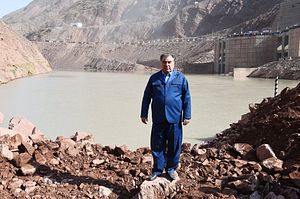The day after a nearly nation-wide blackout, Tajikistan officially began (again) construction on the Rogun dam. To mark the occasion, President Emomali Rahmon drove a bulldozer, pushing a pile of dirt and gravel into the Vakhsh River. Workers lined the construction site, waving Tajik flags. If completed to specifications, the dam would be the world’s tallest at 335 meters.
On October 28 — the day before the Rogun restart ceremony — the country was plunged into darkness. The four-hour blackout affected many parts of Tajikistan. Barqi Tojik, the state power utility, said the cause was an outage at Nurek.
The Rogun dam’s history stretches back to 1976, when initial construction began. But unlike the Nurek dam further downriver — which took 11 years to build and opened in 1972 — Rogun has been stalled for various reasons for four decades.
A 1979 New York Times article exploring the Soviet Union’s looming population problem made mention of Nurek and Rogun as possible parts of a solution which would see Central Asia irrigate and industrialize rather than see its booming population migrate to other parts of Russia. Nurek, at the time, was the world’s tallest dam and hopes were that the impressive Rogun project would not just solve Tajikistan’s energy question but power the region.
By the time the Soviet Union collapsed in 1991, not much progress had been made. The civil war further stalled construction and a flood in 1993 swept away what had been built. In 1994, Russia and Tajikistan agreed to a deal to finish the dam, but it was never implemented. In 2004, Tajikistan and a Russian conglomerate, Rusal, made a deal to finish the dam and construct an aluminium plant.
Three years later, in 2007, the Russian ambassador to Tajikistan said that “[e]ndless insinuations and idle speculation about this issue serve no purpose and are damaging to our relations.” To that end, he said, “We need to come to terms and start implementing the project” and floated that an agreement between Tajikistan and Russia was forthcoming.
The Rusal agreement was dissolved in 2009 — still no dam.
Dushanbe then tried nationalizing the project and selling shares to Tajik citizens to raise funds. International financial institutions — like the IMF — put pressure on the state to cease selling shares. By 2010, slight progress had been made on constructing the needed tunnels to divert the river during construction of the dam proper but construction came to a halt again by 2012, when the World Bank began an impact assessment.
The World Bank’s assessments were finalized in 2014. The results of the technical assessment — which examined various dam height scenarios — landed on the original 335 meter dam. With the highest capacity and therefore longest life expectancy, the assessments greenlit construction again.
Earlier this summer, Salini Impregilo, an Italian company, won the contract to build the dam to the tune of $3.9 billion. The present plan is to have two of the planned six turbines up and running by 2018.
Given the project’s history, skepticism is warranted. All the spoilers that derailed previous pushes to finish the dam remain possibilities; political instability and financial failings could easily balloon costs or delay construction further. Just as demand in Tajikistan has risen — as well as demand in Afghanistan and Pakistan, which hope to buy what Rogun generates — so too has opposition downriver. Islam Karamov, Uzbekistan’s first president, was a staunch opponent of the Rogun project. His likely successor, interim President Shavkat Mirziyoyev, has made surprisingly decent overtures to the neighbors (there have been very symbolic friendship visits between Uzbekistan and Kyrgyzstan with plans for the same with Tajikistan) but it’s impossible to judge at this juncture how he will approach the water issue.
































